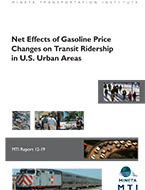- 408-924-7560
- mineta-institute@sjsu.edu
- Donate
Net Effects of Gasoline Price Changes on Transit Ridership in U.S. Urban Areas
Using panel data of transit ridership and gasoline prices for ten selected U.S. urbanized areas over the time period of 2002 to 2011, this study analyzes the effect of gasoline prices on ridership of the four main transit modes—bus, light rail, heavy rail, and commuter rail—as well as their aggregate ridership. Improving upon past studies on the subject, this study accounts for endogeneity between the supply of services and ridership, and controls for a comprehensive list of factors that may potentially influence transit ridership. This study also examines short- and long-term effects and non-constant effects at different gasoline prices.
The analysis found varying effects, depending on transit modes and other conditions. Strong evidence was found for positive short-term effects only for bus and the aggregate: a 0.61-0.62 percent ridership increase in response to a 10 percent increase in current gasoline prices (elasticity of 0.061 to 0.062). The long-term effects of gasoline prices, on the other hand, was significant for all modes and indicated a total ridership increase ranging from 0.84 percent for bus to 1.16 for light rail, with commuter rail, heavy rail, and the aggregate transit in response to a 10 percent increase in gasoline prices. The effects at the higher gasoline price level of over $3 per gallon were found to be more substantial, with a ridership increase of 1.67 percent for bus, 2.05 percent for commuter rail, and 1.80 percent for the aggregate for the same level of gasoline price changes. Light rail shows even a higher rate of increase of 9.34 percent for gasoline prices over $4. In addition, a positive threshold boost effect at the $3 mark of gasoline prices was found for commuter and heavy rails, resulting in a substantially higher rate of ridership increase.
The results of this study suggest that transit agencies should prepare for a potential increase in ridership during peak periods that can be generated by substantial gasoline price increases over $3 per gallon for bus and commuter rail modes, and over $4 per gallon for light rail, in order to accommodate higher transit travel needs of the public through pricing strategies, general financing, capacity management, and operations planning of transit services.
HIROYUKI ISEKI, PhD
Dr. Iseki is an Assistant Professor of Urban Studies and Planning and a research faculty at the National Center for Smart Growth Research and Education of University of Maryland, College Park. His research and teaching interest includes transportation economics and finance, public transit planning and management, travel behavior analysis and modeling, sustainable transportation, regional transportation planning, and applications of GISs to research and practice in public policy and planning. He earned an M.A. and a PhD in Urban Planning from University of California, Los Angeles. For more information, see http://www.arch.umd.edu/ursp/faculty/hiroyuki-iseki andhttp://www.smartgrowth.umd.edu/ hiseki.html.
RUBABA ALI
Rubaba Ali is a PhD candidate at the department of Agricultural and Resource Economics at the University of Maryland, College Park. Her research interests include impact of transport infrastructure on agricultural and non-agricultural sectors and overall welfare in developing countries. She conducts research on energy and transport-related issues in developing and developed countries. She received master’s degrees in Economics and Agricultural and Resource Economics from the University of Maryland, and undergraduate degrees in Mathematics and Economics from Bard College.
-
Contact Us
San José State University One Washington Square, San Jose, CA 95192 Phone: 408-924-7560 Email: mineta-institute@sjsu.edu






